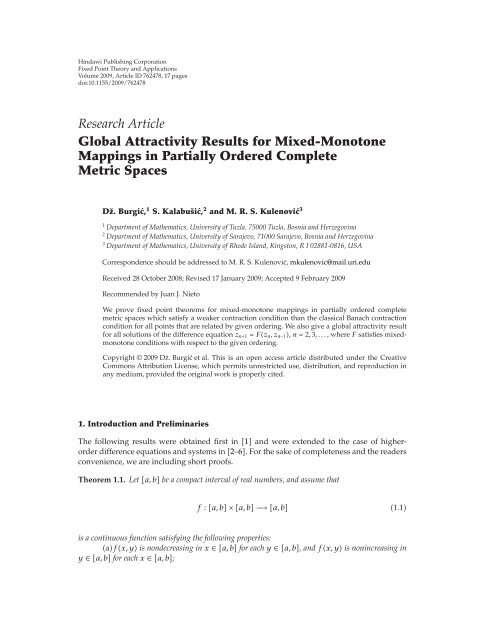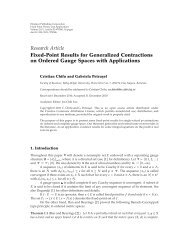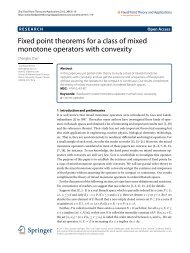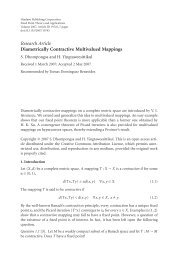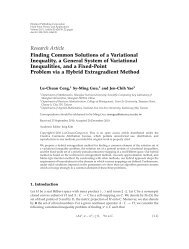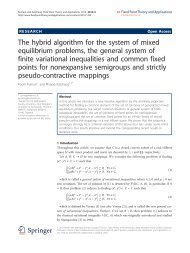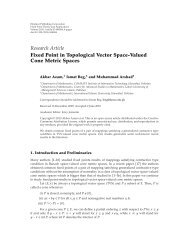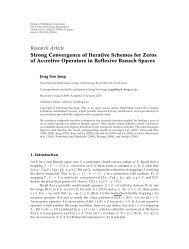View - downloads - Hindawi Publishing Corporation
View - downloads - Hindawi Publishing Corporation
View - downloads - Hindawi Publishing Corporation
You also want an ePaper? Increase the reach of your titles
YUMPU automatically turns print PDFs into web optimized ePapers that Google loves.
<strong>Hindawi</strong> <strong>Publishing</strong> <strong>Corporation</strong><br />
Fixed Point Theory and Applications<br />
Volume 2009, Article ID 762478, 17 pages<br />
doi:10.1155/2009/762478<br />
Research Article<br />
Global Attractivity Results for Mixed-Monotone<br />
Mappings in Partially Ordered Complete<br />
Metric Spaces<br />
Dˇz. Burgić, 1 S. Kalabuˇsić, 2 andM.R.S.Kulenović 3<br />
1 Department of Mathematics, University of Tuzla, 75000 Tuzla, Bosnia and Herzegovina<br />
2 Department of Mathematics, University of Sarajevo, 71000 Sarajevo, Bosnia and Herzegovina<br />
3 Department of Mathematics, University of Rhode Island, Kingston, R I 02881-0816, USA<br />
Correspondence should be addressed to M. R. S. Kulenović, mkulenovic@mail.uri.edu<br />
Received 28 October 2008; Revised 17 January 2009; Accepted 9 February 2009<br />
Recommended by Juan J. Nieto<br />
We prove fixed point theorems for mixed-monotone mappings in partially ordered complete<br />
metric spaces which satisfy a weaker contraction condition than the classical Banach contraction<br />
condition for all points that are related by given ordering. We also give a global attractivity result<br />
for all solutions of the difference equation zn1 Fzn,zn−1, n 2, 3,...,where F satisfies mixedmonotone<br />
conditions with respect to the given ordering.<br />
Copyright q 2009 Dˇz. Burgić et al. This is an open access article distributed under the Creative<br />
Commons Attribution License, which permits unrestricted use, distribution, and reproduction in<br />
any medium, provided the original work is properly cited.<br />
1. Introduction and Preliminaries<br />
The following results were obtained first in 1 and were extended to the case of higherorder<br />
difference equations and systems in 2–6. For the sake of completeness and the readers<br />
convenience, we are including short proofs.<br />
Theorem 1.1. Let a, b be a compact interval of real numbers, and assume that<br />
f : a, b × a, b −→ a, b 1.1<br />
is a continuous function satisfying the following properties:<br />
afx, y is nondecreasing in x ∈ a, b for each y ∈ a, b, and fx, y is nonincreasing in<br />
y ∈ a, b for each x ∈ a, b;
2 Fixed Point Theory and Applications<br />
then m M.<br />
Then<br />
b If m, M ∈ a, b × a, b is a solution of the system<br />
fm, M m, fM, m M, 1.2<br />
xn1 f <br />
xn,xn−1 , n 0, 1,... 1.3<br />
has a unique equilibrium x ∈ a, b and every solution of 1.3 converges to x.<br />
Proof. Set<br />
and for i 1, 2,...set<br />
Now observe that for each i ≥ 0,<br />
Set<br />
Then<br />
and by the continuity of f,<br />
Therefore in view of b,<br />
from which the result follows.<br />
m0 a, M0 b, 1.4<br />
Mi f <br />
Mi−1,mi−1 , mif <br />
mi−1,Mi−1 . 1.5<br />
m0 ≤ m1 ≤···≤mi ≤···≤Mi ≤···≤M1 ≤ M0,<br />
mi ≤ xk ≤ Mi, for k ≥ 2i 1.<br />
1.6<br />
m lim<br />
i →∞ mi, M lim<br />
i →∞ Mi. 1.7<br />
M ≥ lim sup xi ≥ lim inf<br />
i →∞ i →∞ xi ≥ m 1.8<br />
m fm, M, M fM, m. 1.9<br />
m M 1.10
Dˇz. Burgić etal. 3<br />
Theorem 1.2. Let a, b be an interval of real numbers and assume that<br />
is a continuous function satisfying the following properties:<br />
Proof. Set<br />
f : a, b × a, b −→ a, b 1.11<br />
a fx, y is nonincreasing in x ∈ a, b for each y ∈ a, b, and fx, y is nondecreasing in<br />
y ∈ a, b for each x ∈ a, b;<br />
b the difference equation 1.3 has no solutions of minimal period two in a, b. Then1.3<br />
has a unique equilibrium x ∈ a, b and every solution of 1.3 converges to x.<br />
and for i 1, 2,...set<br />
Now observe that for each i ≥ 0,<br />
Set<br />
m0 a, M0 b 1.12<br />
Mi f <br />
mi−1,Mi−1 , mif <br />
Mi−1,mi−1 . 1.13<br />
m0 ≤ m1 ≤···≤mi ≤···≤Mi ≤···≤M1 ≤ M0,<br />
mi ≤ xk ≤ Mi, for k ≥ 2i 1.<br />
Then clearly 1.8 holds and by the continuity of f,<br />
In view of b,<br />
from which the result follows.<br />
1.14<br />
m lim<br />
i →∞ mi, M lim<br />
i →∞ Mi. 1.15<br />
m fM, m, M fm, M. 1.16<br />
m M 1.17<br />
These results have been very useful in proving attractivity results for equilibrium or<br />
periodic solutions of 1.3 as well as for higher-order difference equations and systems of<br />
difference equations; see 2, 7–12. Theorems 1.1 and 1.2 have attracted considerable attention<br />
of the leading specialists in difference equations and discrete dynamical systems and have<br />
been generalized and extended to the case of maps in R n ,see3, and maps in Banach space
4 Fixed Point Theory and Applications<br />
with the cone see 4–6. In this paper, we will extend Theorems 1.1 and 1.2 to the case of<br />
monotone mappings in partially ordered complete metric spaces.<br />
On the other hand, there has been recent interest in establishing fixed point theorems<br />
in partially ordered complete metric spaces with a contractivity condition which holds for<br />
all points that are related by partial ordering; see 13–20. These fixed point results have<br />
been applied mainly to the existence of solutions of boundary value problems for differential<br />
equations and one of them, namely 20, has been applied to the problem of solving matrix<br />
equations. See also 21, where the application to the boundary value problems for integrodifferential<br />
equations is given and 22 for application to some classes of nonexpansive<br />
mappings and 23 for the application of the Leray-Schauder theory to the problems of<br />
an impulsive boundary value problem under the condition of non-well-ordered upper and<br />
lower solutions. None of these results is global result, but they are rather existence results. In<br />
this paper, we combine the existence results with the results of the type of Theorems 1.1 and<br />
1.2 to obtain global attractivity results.<br />
2. Main Results: Mixed Monotone Case I<br />
Let X be a partially ordered set and let d be a metric on X such that X, d is a complete metric<br />
space. Consider X × X. We will use the following partial ordering.<br />
For x, y, u, v ∈ X × X, we have<br />
x, y u, v ⇐⇒ {x ≤ u, y ≥ v}. 2.1<br />
This partial ordering is well known as “south-east ordering” in competitive systems in the<br />
plane; see 5, 6, 12, 24, 25.<br />
Let d1 be a metric on X × X defined as follows:<br />
Clearly<br />
We prove the following theorem.<br />
d1x, y, u, v dx, udy, v. 2.2<br />
d1x, y, u, v d1y, x, v, u. 2.3<br />
Theorem 2.1. Let F : X × X → X be a map such that Fx, y is nonincreasing in x for all y ∈ X,<br />
and nondecreasing in y for all x ∈ X. Suppose that the following conditions hold.<br />
i There exists k ∈ 0, 1 with<br />
dFx, y,Fu, v ≤ k<br />
2 d1x, y, u, v ∀x, y u, v. 2.4<br />
ii There exists x0,y0 ∈ X such that the following condition holds:<br />
x0 ≤ F <br />
y0,x0 , y0≥F <br />
x0,y0 . 2.5
Dˇz. Burgić etal. 5<br />
iii If {xn} ∈ X is a nondecreasing convergent sequence such that limn →∞xn x, then<br />
xn ≤ x, for all n ∈ N and if {yn} ∈ Y is a nonincreasing convergent sequence such<br />
that limn →∞yn y, thenyn ≥ y, for all n ∈ N; ifxn ≤ yn for every n, then<br />
limn →∞xn ≤ limn →∞ yn.<br />
Then we have the following.<br />
a For every initial point x0,y0 ∈ X × X such that condition 2.5 holds, F n x0,y0 →<br />
x, F n y0,x0 → y, n →∞,wherex, y satisfy<br />
x Fy, x, y Fx, y. 2.6<br />
If x0 ≤ y0 in condition 2.5,thenx ≤ y. If in addition x y,then{xn}, {yn} converge to<br />
the equilibrium of the equation<br />
xn1 F <br />
yn,xn , yn1F <br />
xn,yn , n 1, 2,.... 2.7<br />
b In particular, every solution {zn} of<br />
zn1 F <br />
zn,zn−1 , n 2, 3,... 2.8<br />
such that x0 ≤ z0, z1 ≤ y0 converges to the equilibrium of 2.8.<br />
c The following estimates hold:<br />
d F n 1<br />
y0,x0 ,x ≤<br />
2<br />
d F n 1<br />
x0,y0 ,y ≤<br />
2<br />
k n<br />
1 − k<br />
k n<br />
1 − k<br />
<br />
d F x0,y0 ,y0 d F y0,x0 ,x0 , 2.9<br />
<br />
d F y0,x0 ,x0 d F x0,y0 ,y0 . 2.10<br />
Proof. Let x1 Fy0,x0 and y1 Fx0,y0. Since x0 ≤ Fy0,x0 x1 and y0 ≥ Fx0,y0 y1,<br />
for x2 Fy1,x1, y2 Fx1,y1, we have<br />
Now, we have<br />
F 2 <br />
y0,x0 : F F x0,y0 ,F y0,x0 F y1,x1 x2,<br />
F 2 <br />
x0,y0 : F F y0,x0 ,F x0,y0 F x1,y1 y2.<br />
x2 F 2 <br />
y0,x0 F y1,x1 ≥ F y0,x0 x1,<br />
y2 F 2 <br />
x0,y0 F x1,y1 ≤ F x0,y0 y1.<br />
2.11<br />
2.12
6 Fixed Point Theory and Applications<br />
For n 1, 2,...,we let<br />
By using the monotonicity of F, weobtain<br />
that is<br />
xn1 F n1 n<br />
y0,x0 F F n<br />
x0,y0 ,F <br />
y0,x0 ,<br />
yn1 F n1 n<br />
x0,y0 F F n<br />
y0,x0 ,F <br />
x0,y0 .<br />
x0 ≤ F <br />
y0,x0 x1 ≤ F 2 <br />
y0,x0 x2 ≤···≤F n1 <br />
y0,x0 ≤··· ,<br />
y0 ≥ F <br />
x0,y0 y1 ≥ F 2 <br />
x0,y0 y2 ≥···≥F n1 <br />
x0,y0 ≥···<br />
x0 ≤ x1 ≤ x2 ≤···<br />
y0 ≥ y1 ≥ y2 ≥··· .<br />
We claim that for all n ∈ N the following inequalities hold:<br />
2.13<br />
2.14<br />
2.15<br />
d n1<br />
xn1,xn d F n<br />
y0,x0 ,F k<br />
y0,x0 ≤ n<br />
2 d1<br />
<br />
x1,y1 , x0,y0 , 2.16<br />
d n1<br />
yn1,yn d F n<br />
x0,y0 ,F k<br />
x0,y0 ≤ n<br />
2 d1<br />
<br />
x1,y1 , x0,y0 . 2.17<br />
Indeed, for n 1, using x0 ≤ Fy0,x0, y0 ≥ Fx0,y0, and2.3,weobtain<br />
d k<br />
x2,x1 d F y1,x1 ,F y0,x0 ≤<br />
2 d1<br />
d <br />
y2,y1 d Fx1,y1 ,F x0,y0<br />
Assume that 2.16 holds. Using the inequalities<br />
k<br />
y1,x1 , y0,x0 <br />
F n1 n<br />
y0,x0 ≥ F <br />
y0,x0 ,<br />
F n1 n<br />
x0,y0 ≤ F <br />
x0,y0 ,<br />
2 d1<br />
<br />
x1,y1 , x0,y0 ,<br />
k<br />
≤<br />
2 d1<br />
<br />
x1,y1 , x0,y0 .<br />
2.18<br />
2.19
Dˇz. Burgić etal. 7<br />
and the contraction condition 2.4, we have<br />
d n2<br />
xn2,xn1 d F n1<br />
y0,x0 ,F <br />
y0,x0<br />
d F F n1 n1<br />
x0,y0 ,F n<br />
y0,x0 ,F F n<br />
x0,y0 ,F <br />
y0,x0<br />
Similarly,<br />
≤ k n1<br />
d F<br />
2<br />
n<br />
x0,y0 ,F n1<br />
x0,y0 d F n<br />
y0,x0 ,F <br />
y0,x0<br />
≤ k<br />
n k <br />
d F x0,y0 ,y0 d F y0,x0 ,x0 d F y0,x0 ,x0<br />
2 2<br />
d F <br />
x0,y0 ,y0<br />
<br />
kn1<br />
2 d1<br />
<br />
x1,y1 , x0,y0 .<br />
2.20<br />
d n2<br />
yn2,yn1 d F n1<br />
x0,y0 ,F k<br />
x0,y0 ≤ n1<br />
2 d1<br />
<br />
x1,y1 , x0,y0 . 2.21<br />
This implies that {xn} {F n y0,x0} and {yn} {F n x0,y0} are Cauchy sequences in X.<br />
Indeed,<br />
d F n np<br />
y0,x0 ,F n<br />
y0,x0 ≤ d F n1<br />
y0,x0 ,F <br />
y0,x0 ···<br />
d F np−1 np<br />
y0,x0 ,F <br />
y0,x0<br />
≤ kn<br />
2 dF <br />
x0,y0 ,y0 d F y0,x0 ,x0 ···<br />
knp−1 <br />
d F x0y0 ,y0 d F y0,x0 ,x0<br />
2<br />
kn 2 p−1<br />
1 k k ··· k<br />
2<br />
d F <br />
x0,y0 ,y0 dF y0,x0 ,x0<br />
kn<br />
2<br />
Since k ∈ 0, 1, we have<br />
1 − kp <br />
d F x0,y0 ,y0 d F y0,x0 ,x0 .<br />
1 − k<br />
2.22<br />
d n<br />
xn,xnp d F np<br />
y0,x0 ,F k<br />
y0,x0 ≤<br />
n<br />
21 − k d1<br />
<br />
x1,y1 , x0,y0 . 2.23
8 Fixed Point Theory and Applications<br />
Using 2.23, we conclude that {xn} {Fny0,x0} is a Cauchy sequence. Similarly, we<br />
conclude that {yn} {Fnx0,y0} is a Cauchy sequence. Since X is a complete metric space,<br />
then there exist x, y ∈ X such that<br />
lim<br />
n →∞ xn lim F<br />
n →∞ n <br />
y0,x0 x, lim yn lim<br />
n →∞ m →∞ Fm <br />
x0,y0 y. 2.24<br />
Using the continuity of F, which follows from contraction condition 2.4, the equations<br />
xn1 F <br />
yn,xn , yn1F <br />
xn,yn<br />
2.25<br />
imply 2.6.<br />
Assume that x0 ≤ y0. Then, in view of the monotonicity of F<br />
x1 F <br />
y0,x0 ≤ F x0,y0 y1,<br />
x2 F <br />
y1,x1 ≤ F x1,y1 y2,<br />
x3 F <br />
y2,x2 ≤ F x2,y2 y3.<br />
2.26<br />
By using induction, we can show that xn ≤ yn for all n. Assume that x0 ≤ z0, z1≤ y0. Then,<br />
in view of the monotonicity of F, we have<br />
x1 F <br />
y0,x0 ≤ F z1,z0 z2 ≤ F <br />
x0,y0 y1,<br />
x1 F <br />
y0,x0 ≤ F z2,z1 z3 ≤ F 2.27<br />
x0,y0 y1.<br />
Continuing in a similar way we can prove that xi ≤ zk ≤ yi for all k ≥ 2i1. By using condition<br />
iii we conclude that whenever limn →∞zk exists we must have<br />
which in the case when x y implies limk →∞zk x.<br />
By letting p →∞in 2.23, we obtain the estimate 2.9.<br />
x ≤ lim<br />
k →∞ zk ≤ y 2.28<br />
Remark 2.2. Property iii is usually called closedness of the partial ordering, see 6, andis<br />
an important ingredient of the definition of an ordered L-space; see 17, 19.<br />
Theorem 2.3. Assume that along with conditions (i) and (ii) of Theorem 2.1, the following condition<br />
is satisfied:<br />
iv every pair of elements has either a lower or an upper bound.<br />
Then, the fixed point x, y is unique and x y.<br />
Proof. First, we prove that the fixed point x, y is unique. Condition iv is equivalent to the<br />
following. For every x, y, x ∗ ,y ∗ ∈ X × X, there exists z1,z2 ∈ X × X that is comparable<br />
to x, y, x ∗ ,y ∗ . See 16.<br />
Let x, y and x ∗ ,y ∗ be two fixed points of the map F.
Dˇz. Burgić etal. 9<br />
We consider two cases.<br />
Case 1. If x, y is comparable to x ∗ ,y ∗ , then for all n 0, 1, 2,...F n y, x,F n x, y is<br />
comparable to F n y ∗ ,x ∗ ,F n x ∗ ,y ∗ x ∗ ,y ∗ . We have to prove that<br />
Indeed, using 2.2, weobtain<br />
∗ ∗<br />
d1 x, y, x ,y d x, x ∗ d y, y ∗<br />
∗ ∗<br />
d1 x, y, x ,y 0. 2.29<br />
d F n y, x,F n y ∗ ,x ∗ d F n x, y,F n x ∗ ,y ∗ .<br />
We estimate dF n y, x,F n y ∗ ,x ∗ ,anddF n x, y,F n x ∗ ,y ∗ .<br />
First, by using contraction condition 2.4, we have<br />
d Fy, x,F y ∗ ,x ∗ ≤ k ∗<br />
d y, y<br />
2<br />
d x, x ∗ k<br />
2 d1<br />
∗ ∗<br />
x, y, x ,y ,<br />
d Fx, y,F x ∗ ,y ∗ ≤ k ∗<br />
d x, x<br />
2<br />
d y, y ∗ k<br />
2 d1<br />
∗ ∗<br />
x, y, x ,y .<br />
Now, by using 2.31 and 2.30, we have<br />
which implies that<br />
2.30<br />
2.31<br />
∗ ∗<br />
d1 x, y, x ,y ∗ ∗<br />
≤ kd1 x, y, x ,y ∗ ∗<br />
10 Fixed Point Theory and Applications<br />
Now, we obtain<br />
∗ ∗<br />
d1 x, y, x ,y d F n y, x,F n n<br />
z2,z1 d F n<br />
z2,z1 ,F y ∗ ,x ∗<br />
d F n n<br />
z1,z2 ,F x ∗ ,y ∗ d F n n<br />
z2,z1 ,F y ∗ ,x ∗ .<br />
We now estimate the right-hand side of 2.35.<br />
First, by using<br />
d Fy, x,F z2,z1<br />
2.35<br />
k <br />
≤ d y, z2 d x, z1 , 2.36<br />
2<br />
we have<br />
d F 2 y, x,F 2 <br />
z2,z1 d FFx, y,Fy, x,F F z1,z2 ,F z2,z1<br />
Similarly,<br />
So,<br />
≤ k<br />
2 dFx, y,F <br />
z1,z2 d Fy, x,F z2,z1 <br />
≤ k<br />
<br />
k k <br />
d x, z1 d y, z2 d y, z2 d x, z1<br />
2 2<br />
2<br />
<br />
k2 <br />
d x, z1 dy, z2 .<br />
2<br />
d F 2 x, y,F 2 <br />
z1,z2 d FFy, x,Fx, y,F F z2,z1 ,F z1,z2<br />
≤ k <br />
d Fy, x,F z2,z1 d Fx, y ,F z1,z2<br />
2<br />
≤ k<br />
<br />
k k <br />
d y, z2 d x, z1 d y, z2 d x, z1<br />
2 2<br />
2<br />
<br />
k2 <br />
d x, z1 d y, z2 .<br />
2<br />
d F 2 y, x,F 2 k<br />
z2,z1 ≤ 2 <br />
d x, z1 d y, z2 ,<br />
2<br />
d F 2 x, y,F 2 k<br />
z1,z2 ≤ 2 <br />
d x, z1 d y, z2 .<br />
2<br />
2.37<br />
2.38<br />
2.39
Dˇz. Burgić etal. 11<br />
Using induction, we obtain<br />
d F n y, x,F n k<br />
z2,z1 ≤ n <br />
d x, z1 d y, z2 ,<br />
2<br />
d F n x, y,F n k<br />
z1,z2 ≤ n <br />
d x, z1 dy, z2 ,<br />
2<br />
d F n z2,z1<br />
d F n z1,z2<br />
Using 2.40,relation2.35 becomes<br />
So,<br />
d1<br />
∗ ∗<br />
x, y, x ,y ≤ kn <br />
d x, z1 d y, z2<br />
2<br />
n<br />
,F y ∗ ,x ∗ ≤ kn <br />
d z1,x<br />
2<br />
∗ ,d z2,y ∗ ,<br />
n<br />
,F x ∗ ,y ∗ ≤ kn <br />
d z1,x<br />
2<br />
∗ ,d z2,y ∗ .<br />
k n<br />
2<br />
<br />
d x, z1 d y, z2<br />
2.40<br />
kn <br />
d z1,x<br />
2<br />
∗ d z2,y ∗ kn <br />
d z1,x<br />
2<br />
∗ d z2,y ∗<br />
k n d <br />
x, z1 d y, z2 d z1,x ∗ d z2,y ∗ −→ 0, n −→ ∞.<br />
2.41<br />
∗ ∗<br />
d1 x, y, x ,y 0. 2.42<br />
Finally, we prove that x y. We will consider two cases.<br />
Case A. If x is comparable to y, then Fy, x x is comparable to Fx, y y. Now, we obtain<br />
since k ∈ 0, 1, this implies<br />
dx, y dFy, x,Fx, y ≤ k<br />
dx, ydy, x kdx, y, 2.43<br />
2<br />
dx, y 0 ⇐⇒ x y. 2.44<br />
Case B. If x is not comparable to y, then there exists an upper bound or alower bound of x<br />
and y, that is, there exists z ∈ X such that x ≤ z, y ≤ z. Then by using monotonicity character
12 Fixed Point Theory and Applications<br />
of F, we have<br />
Now,<br />
that is<br />
Furthermore,<br />
that is<br />
Similarly,<br />
that is<br />
and<br />
By using induction, we have<br />
Fx, y ≤ Fx, z, Fy, x ≤ Fy, z,<br />
Fx, y ≥ Fz, y, Fy, x ≥ Fz, x.<br />
2.45<br />
F 2 x, y FFy, x,Fx, y ≤ FFz, x,Fx, z F 2 x, z, 2.46<br />
F 2 x, y ≤ F 2 x, z. 2.47<br />
F 2 x, y FFy, x,Fx, y ≥ FFy, z,Fz, y F 2 y, z, 2.48<br />
F 2 x, y ≥ F 2 y, z. 2.49<br />
F 2 y, x FFx, y,Fy, x ≤ FFz, y,Fy, z F 2 y, z, 2.50<br />
F 2 y, x ≤ F 2 y, z, 2.51<br />
F 2 y, x FFx, y,Fy, x ≥ FFx, z,Fz, x F 2 z, x. 2.52<br />
F n1 x, y ≤ F n1 x, z,<br />
F n1 x, y ≥ F n1 y, z,<br />
F n1 y, x ≤ F n1 y, z,<br />
F n1 y, x ≥ F n1 z, x.<br />
2.53
Dˇz. Burgić etal. 13<br />
Since x, y is a fixed point, we obtain<br />
dx, y d F n1 y, x,F n1 x, y <br />
d F F n x, y,F n y, x ,F F n y, x,F n x, y <br />
≤ d F F n x, y,F n y, x ,F F n x, z,F n z, x <br />
d F F n x, z,F n z, x ,F F n y, x,F n x, y <br />
≤ d F F n x, y,F n y, x ,F F n x, z,F n z, x <br />
d F F n z, x,F n x, z ,F F n x, z,F n z, x <br />
d F F n y, x,F n x, y ,F F n z, x,F n x, z .<br />
Using the contractivity condition 2.4 on F, we have<br />
dx, y ≤ k <br />
n n n n<br />
d F x, y,F x, z d F y, x,F z, x<br />
2<br />
k <br />
n n n n<br />
d F z, x,F x, z d F x, z,F z, x<br />
2<br />
k <br />
n n n n<br />
d F y, x,F z, x d F y, x,F x, y<br />
2<br />
k <br />
n n n n n n<br />
2d F x, y,F x, z 2d F y, x,F z, x 2d F x, z,F z, x<br />
2<br />
k d F n x, y,F n x, z d F n y, x,F n z, x d F n x, z,F n z, x .<br />
Now, we estimate the terms on the right-hand side<br />
d F n x, y,F n x, z d F F n−1 y, x,F n−1 x, y ,F F n−1 z, x,F n−1 x, z <br />
≤ k n−1 n−1 n−1 n−1<br />
d F y, x,F z, x d F x, y,F x, z ,<br />
2<br />
d F n y, x,F n z, x d F F n−1 x, y,F n−1 y, x ,F F n−1 x, z,F n−1 z, x <br />
≤ k n−1 n−1 n−1 n−1<br />
d F x, y,F x, z d F y, x,F z, x ,<br />
2<br />
d F n x, z,F n z, x d F F n−1 z, x,F n−1 x, z ,F F n−1 x, z,F n−1 z, x <br />
≤ k n−1 n−1 n−1 n−1<br />
d F z, x,F x, z d F x, z,F z, x .<br />
2<br />
2.54<br />
2.55<br />
2.56
14 Fixed Point Theory and Applications<br />
Now, we have<br />
dx, y ≤ k 2 d F n−1 y, x,F n−1 z, x d F n−1 x, y,F n−1 x, z d F n−1 z, x,F n−1 x, z .<br />
2.57<br />
Continuing this process, we obtain<br />
dx, y ≤ k n dFy, x,Fz, x dFx, y,Fx, z dFz, x,Fx, z. 2.58<br />
Using the contractivity of F, we have<br />
That is<br />
So,<br />
dx, y ≤ k n<br />
<br />
k<br />
dx, xdy, zdy, zdx, xdx, zdz, x<br />
2<br />
k n1 dy, zdz, x.<br />
2.59<br />
dx, y ≤ k n1 dy, zdz, x −→ 0, n −→ ∞. 2.60<br />
3. Main Results: Mixed Monotone Case II<br />
dx, y 0 ⇐⇒ x y. 2.61<br />
Let X be a partially ordered set and let d be a metric on X such that X, d is a complete metric<br />
space. Consider X × X. We will use the following partial order.<br />
For x, y, u, v ∈ X × X, we have<br />
Let d1 be a metric on X × X defined as follows:<br />
x, y u, v ⇐⇒ {x ≥ u, y ≤ v}. 3.1<br />
d1x, y, u, v dx, udy, v. 3.2<br />
The following two theorems have similar proofs to the proofs of Theorems 2.1 and 2.3,<br />
respectively, and so their proofs will be skipped. Significant parts of these results have been<br />
included in 14 and applied successfully to some boundary value problems in ordinary<br />
differential equations.
Dˇz. Burgić etal. 15<br />
Theorem 3.1. Let F : X × X → X be a map such that Fx, y is nondecreasing in x for all y ∈ X,<br />
and nonincreasing in y for all x ∈ X. Suppose that the following conditions hold.<br />
i There exists k ∈ 0, 1 with<br />
dFx, y,Fu, v ≤ k<br />
2 d1x, y, u, v ∀x, y u, v. 3.3<br />
ii There exists x0,y0 ∈ X such that the following condition holds:<br />
x0 ≤ F <br />
x0,y0 , y0≥F <br />
y0,x0 . 3.4<br />
iii If {xn} ∈ X is a nondecreasing convergent sequence such that limn →∞xn x, then<br />
xn ≤ x, for all n ∈ N and if {yn} ∈ Y is a nonincreasing convergent sequence such<br />
that limn →∞yn y, thenyn ≥ y, for all n ∈ N; ifxn ≤ yn for every n, then<br />
limn →∞xn ≤ limn →∞yn.<br />
Then we have the following.<br />
a For every initial point x0,y0 ∈ X × X such that the condition 3.2 holds, F n x0,y0 →<br />
x, F n y0,x0 → y, n →∞,wherex, y satisfy<br />
x Fx, y, y Fy, x. 3.5<br />
If x0 ≤ y0 in condition 3.4,thenx≤y. If in addition x y,then{xn}, {yn} converge to<br />
the equilibrium of the equation<br />
xn1 F <br />
xn,yn , yn1F <br />
yn,xn , n 1, 2,.... 3.6<br />
b In particular, every solution {zn} of<br />
zn1 F <br />
zn,zn−1 , n 2, 3,... 3.7<br />
such that x0 ≤ z0,z1 ≤ y0 converges to the equilibrium of 3.7.<br />
c The following estimates hold:<br />
d F n 1<br />
x0,y0 ,x ≤<br />
2<br />
d F n 1<br />
y0,x0 ,y ≤<br />
2<br />
k n<br />
1 − k<br />
k n<br />
1 − k<br />
<br />
d F x0,y0 ,x0 d F y0,x0 ,y0 ,<br />
<br />
d F x0,y0 ,x0 d F y0,x0 ,y0 .<br />
Theorem 3.2. Assume that along with conditions (i) and (ii) of Theorem 3.1, the following condition<br />
is satisfied:<br />
iv every pair of elements has either a lower or an upper bound.<br />
Then, the fixed point x, y is unique and x y.<br />
3.8
16 Fixed Point Theory and Applications<br />
Remark 3.3. Theorems 3.1 and 3.2 generalize and extend the results in 14. The new feature<br />
of our results is global attractivity part that extends Theorems 1.1 and 1.2. Most of presented<br />
ideas were presented for the first time in 14.<br />
Acknowledgment<br />
The authors are grateful to the referees for pointing out few fine details that improved the<br />
presented results.<br />
References<br />
1 M. R. S. Kulenović, G. Ladas, and W. S. Sizer, “On the recursive sequence xn1 αxn βxn−1/γxn <br />
δxn−1,” Mathematical Sciences Research Hot-Line, vol. 2, no. 5, pp. 1–16, 1998.<br />
2 M. R. S. Kulenović and G. Ladas, Dynamics of Second Order Rational Difference Equations: With Open<br />
Problems and Conjecture, Chapman & Hall/CRC, Boca Raton, Fla, USA, 2002.<br />
3 M. R. S. Kulenović and O. Merino, “A global attractivity result for maps with invariant boxes,”<br />
Discrete and Continuous Dynamical Systems. Series B, vol. 6, no. 1, pp. 97–110, 2006.<br />
4 R. D. Nussbaum, “Global stability, two conjectures and Maple,” Nonlinear Analysis: Theory, Methods &<br />
Applications, vol. 66, no. 5, pp. 1064–1090, 2007.<br />
5 H. L. Smith, “The discrete dynamics of monotonically decomposable maps,” Journal of Mathematical<br />
Biology, vol. 53, no. 4, pp. 747–758, 2006.<br />
6 H. L. Smith, “Global stability for mixed monotone systems,” Journal of Difference Equations and<br />
Applications, vol. 14, no. 10-11, pp. 1159–1164, 2008.<br />
7 E. Camouzis and G. Ladas, Dynamics of Third-Order Rational Difference Equations with Open Problems<br />
and Conjectures, vol. 5 of Advances in Discrete Mathematics and Applications, Chapman & Hall/CRC,<br />
Boca Raton, Fla, USA, 2008.<br />
8 C. H. Gibbons, M. R. S. Kulenović, and G. Ladas, “On the recursive sequence xn1 α βxn−1/γ <br />
xn,” Mathematical Sciences Research Hot-Line, vol. 4, no. 2, pp. 1–11, 2000.<br />
9 C. H. Gibbons, M. R. S. Kulenović, G. Ladas, and H. D. Voulov, “On the trichotomy character of<br />
xn1 α βxn γxn−1/A xn,” Journal of Difference Equations and Applications, vol. 8, no. 1, pp.<br />
75–92, 2002.<br />
10 E. A. Grove and G. Ladas, Periodicities in Nonlinear Difference Equations, vol. 4 of Advances in Discrete<br />
Mathematics and Applications, Chapman & Hall/CRC, Boca Raton, Fla, USA, 2005.<br />
11 M. R. S. Kulenović and O. Merino, Discrete Dynamical Systems and Difference Equations with<br />
Mathematica, Chapman & Hall/CRC, Boca Raton, Fla, USA, 2002.<br />
12 M. R. S. Kulenović and M. Nurkanović, “Asymptotic behavior of a system of linear fractional<br />
difference equations,” Journal of Inequalities and Applications, vol. 2005, no. 2, pp. 127–143, 2005.<br />
13 R. P. Agarwal, M. A. El-Gebeily, and D. O’Regan, “Generalized contractions in partially ordered<br />
metric spaces,” Applicable Analysis, vol. 87, no. 1, pp. 109–116, 2008.<br />
14 T. Gnana Bhaskar and V. Lakshmikantham, “Fixed point theorems in partially ordered metric spaces<br />
and applications,” Nonlinear Analysis: Theory, Methods & Applications, vol. 65, no. 7, pp. 1379–1393,<br />
2006.<br />
15 J. J. Nieto and R. Rodríguez-López, “Existence and uniqueness of fixed point in partially ordered<br />
sets and applications to ordinary differential equations,” Acta Mathematica Sinica, vol. 23, no. 12, pp.<br />
2205–2212, 2007.<br />
16 J. J. Nieto and R. Rodríguez-López, “Contractive mapping theorems in partially ordered sets and<br />
applications to ordinary differential equations,” Order, vol. 22, no. 3, pp. 223–239, 2005.<br />
17 J. J. Nieto, R. L. Pouso, and R. Rodríguez-López, “Fixed point theorems in ordered abstract spaces,”<br />
Proceedings of the American Mathematical Society, vol. 135, no. 8, pp. 2505–2517, 2007.<br />
18 D. O’Regan and A. Petrus¸el, “Fixed point theorems for generalized contractions in ordered metric<br />
spaces,” Journal of Mathematical Analysis and Applications, vol. 341, no. 2, pp. 1241–1252, 2008.<br />
19 A. Petrus¸el and I. A. Rus, “Fixed point theorems in ordered L-spaces,” Proceedings of the American<br />
Mathematical Society, vol. 134, no. 2, pp. 411–418, 2006.
Dˇz. Burgić etal. 17<br />
20 A. C. M. Ran and M. C. B. Reurings, “A fixed point theorem in partially ordered sets and some<br />
applications to matrix equations,” Proceedings of the American Mathematical Society, vol. 132, no. 5, pp.<br />
1435–1443, 2004.<br />
21 B. Ahmad and J. J. Nieto, “The monotone iterative technique for three-point second-order<br />
integrodifferential boundary value problems with p-Laplacian,” Boundary Value Problems, vol. 2007,<br />
Article ID 57481, 9 pages, 2007.<br />
22 Y. Su, D. Wang, and M. Shang, “Strong convergence of monotone hybrid algorithm for hemi-relatively<br />
nonexpansive mappings,” Fixed Point Theory and Applications, vol. 2008, Article ID 284613, 8 pages,<br />
2008.<br />
23 X. Xian, D. O’Regan, and R. P. Agarwal, “Multiplicity results via topological degree for impulsive<br />
boundary value problems under non-well-ordered upper and lower solution conditions,” Boundary<br />
Value Problems, vol. 2008, Article ID 197205, 21 pages, 2008.<br />
24 M. R. S. Kulenović and O. Merino, “Competitive-exclusion versus competitive-coexistence for<br />
systems in the plane,” Discrete and Continuous Dynamical Systems. Series B, vol. 6, no. 5, pp. 1141–1156,<br />
2006.<br />
25 H. L. Smith, “Planar competitive and cooperative difference equations,” Journal of Difference Equations<br />
and Applications, vol. 3, no. 5-6, pp. 335–357, 1998.


